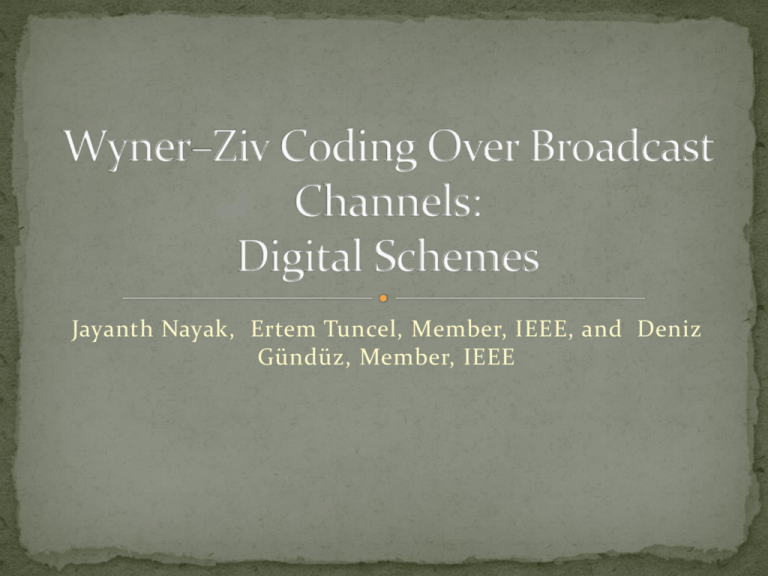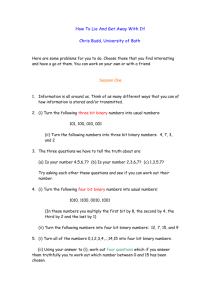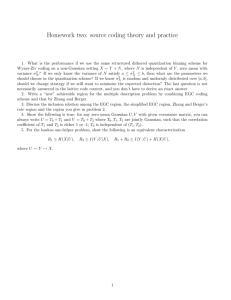Wyner VZiv Coding Over Broadcast Channels
advertisement

Jayanth Nayak, Ertem Tuncel, Member, IEEE, and Deniz Gündüz, Member, IEEE DPC : dirty paper coding CSI : channel state information CL : common layer RL : refinement layer LDS : Layered Description scheme Introduction Background and notation A basic WZBC scheme A layered WZBC scheme Source coding rates for LDS PERFORMANCE ANALYSIS FOR THE QUADRATIC GAUSSIAN PROBLEM PERFORMANCE ANALYSIS FOR THE BINARY HAMMING PROBLEM CONCLUSIONS AND FUTURE WORK We study the communication scenario in which one of the sensors is required to transmit its measurements to the other nodes over a broadcast channel. The receiver nodes are themselves equipped with side information unavailable to the sender, lossless transmission (in the Shannon sense) is possible with channel uses per source symbol if and only if there exists a channel input distribution that such The optimal coding scheme is not separable in the classical sense, but consists of separate components that perform source and channel coding in a broader sense. This results in the separation of source and channel variables as in (1). If the broadcast channel is such that the same input distribution achieves capacity for all individual channels, then (1) implies that one can utilize all channels at full capacity. Binary symmetric channels and Gaussian channels are the widely known examples of this phenomenon. The optimal coding scheme does not explicitly involve binning, In this paper, we consider the general lossy coding problem in which the reconstruction of the source at the receivers need not be perfect. We shall refer to this problem setup as Wyner–Ziv coding over broadcast channels (WZBC). We present a coding scheme for this scenario and analyze its performance in the quadratic Gaussian and binary Hamming cases. In telecommunications, dirty paper coding (DPC) is a technique for efficient transmission of digital data through a channel that is subject to some interference that is known to the transmitter. The technique consists of precoding the data so as to cancel the effect of the interference. Introduction Background and notation A basic WZBC scheme A layered WZBC scheme Source coding rates for LDS PERFORMANCE ANALYSIS FOR THE QUADRATIC GAUSSIAN PROBLEM PERFORMANCE ANALYSIS FOR THE BINARY HAMMING PROBLEM CONCLUSIONS AND FUTURE WORK be random variables denoting a source with independent and identically distributed (i.i.d.) realizations. Source X is to be transmitted over a memoryless broadcast channel defined by Decoder k has access to side information addition to the channel output in single-letter distortion measures Definition 1: An code consists of an encoder and decoders at each receiver The rate of the code symbol is channel uses per source A distortion tuple is said to be achievable at a rational rate if for every , there exists such that for all integers with , there exists an code satisfying In this paper, we present some general WZBC techniques and derive the corresponding achievable distortion regions. We study the performance of these techniques for the following cases. Quadratic Gaussian Binary Hamming the case . Since ,we shall drop the subscripts that relate to the receiver. The Wyner– Ziv rate-distortion performance is characterized as is an auxiliary random variable ,and the capacity of the channel is well-known to be It is then straightforward to conclude that combining separate source and channel codes yields the distortion On the other hand, a converse result in [15] shows that even by using joint source-channel codes, one cannot improve the distortion performance further than (3). We are further interested in the evaluation of ,as well as in the test channels achieving it, for the quadratic Gaussian and binary Hamming cases. It was shown in [22] that the optimal backward test channel is given by where and are independent Gaussians. For the rate we have The optimal reconstruction is a linear estimate which yields the distortion and therefore It was implicitly shown in [23] that the optimal auxiliary random variable is given by where are all independent, and are and with and , respectively, and an erasure operator, i.e., This choice results in is Where with denoting the binary convolution, i.e., , and denoting the binary entropy function, i.e., At each terminal, no WZBC scheme can achieve a distortion less than the minimum distortion achievable by ignoring the other terminals. Thus there is considerable simplification in the quadratic Gaussian and binary Hamming cases since the channel and the side information are degraded in both cases: we can assume that one of the two Markov chains or holds (for arbitrary channel input ) for the channel or holds for the source. Introduction Background and notation A basic WZBC scheme A layered WZBC scheme Source coding rates for LDS PERFORMANCE ANALYSIS FOR THE QUADRATIC GAUSSIAN PROBLEM PERFORMANCE ANALYSIS FOR THE BINARY HAMMING PROBLEM CONCLUSIONS AND FUTURE WORK Introduction Background and notation A basic WZBC scheme A layered WZBC scheme Source coding rates for LDS PERFORMANCE ANALYSIS FOR THE QUADRATIC GAUSSIAN PROBLEM PERFORMANCE ANALYSIS FOR THE BINARY HAMMING PROBLEM CONCLUSIONS AND FUTURE WORK the side information and channel characteristics at the two receiving terminals can be very different, we might be able to improve the performance by layered coding, i.e., by not only transmitting a common layer (CL) to both receivers but also additionally transmitting a refinement layer (RL) to one of the two receivers. Since there are two receivers, we are focusing on coding with only two layers because intuitively, more layers targeted for the same receiver can only degrade the performance. CL : c RL : r In this scheme, illustrated in Fig. 2, the CL is coded using CDS with DPC with the RL codeword acting as CSI. Introduction Background and notation A basic WZBC scheme A layered WZBC scheme Source coding rates for LDS PERFORMANCE ANALYSIS FOR THE QUADRATIC GAUSSIAN PROBLEM PERFORMANCE ANALYSIS FOR THE BINARY HAMMING PROBLEM CONCLUSIONS AND FUTURE WORK Introduction Background and notation A basic WZBC scheme A layered WZBC scheme Source coding rates for LDS PERFORMANCE ANALYSIS FOR THE QUADRATIC GAUSSIAN PROBLEM PERFORMANCE ANALYSIS FOR THE BINARY HAMMING PROBLEM CONCLUSIONS AND FUTURE WORK Introduction Background and notation A basic WZBC scheme A layered WZBC scheme Source coding rates for LDS PERFORMANCE ANALYSIS FOR THE QUADRATIC GAUSSIAN PROBLEM PERFORMANCE ANALYSIS FOR THE BINARY HAMMING PROBLEM CONCLUSIONS AND FUTURE WORK




